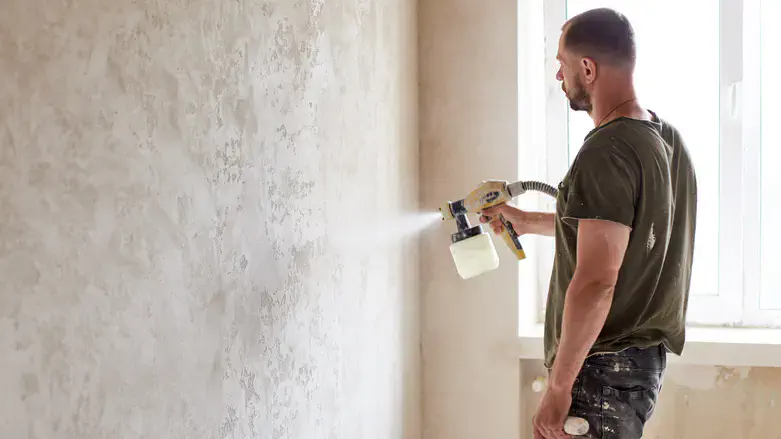
Spray painting promises a smooth, even finish and increases the speed of paint application, especially for larger areas. Once sprayed, though, the paint is atomized to the fine particles, creating the risk of overspray-an ambush of undesirable paint everywhere on just about anything that was not intended to be coated. The very thought of cleaning all of it, furniture, floors, and trims, can discourage even a very keen DIYer. If, however, you make proper preparations and employ the right technique, you can master "spraying walls" without a battering of chaos and paint! The best spray machine is the initial investment, but clever preparation coupled with well-controlled application is what finishes the job cleanly.
Once the spray gun gets to you, the next key step definitely involves preparing the work area to control paint fumes too dangerous to breathe. That includes more than pushing furniture aside; you build a contained environment that traps the overspray and keeps belongings safe. One could think of it as erecting a temporary spray booth within their room. The set-up time goes a long way in cutting the clean-up time and providing a stress-free painting experience.
1. The Art of Meticulous Masking:
The most important key to preventing overspray is a thorough masking job. It would include anything that is unwanted to be sprayed on to be masked with some protective material.
On Floors: Drop cloths of canvas or thick plastic sheeting should be used to cover the entire floor surface. Overlap the drop cloth edges and tape with painter's tape to the baseboards. Canvas drop cloths are more sturdy and rarely tear. Plastic ones, however, are simple to clean-if overspray manages to fall upon the surface.
Trim and Ceilings: Use high quality tape (the blue or green one for easy removal) along all trim areas, including the baseboards, door, and window casings crown molding. For ceilings, tape carefully along the wall-ceiling edge. Ensure that the tape is sealed tightly.
Furniture and Fixtures: Remove from the room as much furniture as you can. Items that can't be removed should be almost entirely wrapped with plastic sheeting and sealed with tape. This also includes light fixtures, electrical outlets, and switches. As an additional level of protection, you may want to remove the outlet and switch covers and tape over the openings.
Doors and Windows: Cover doors and windows completely with plastic sheeting if you are not going to paint them.
2. Creating a Controlled Environment:
While masking protects surfaces, creating a containment area will help to limit the dispersion of airborne paint particles.
Seal the Room: Keep all doors and windows shut to block drafts that could carry overspray to other areas in your house.
Ventilation and Control: While minimizing drafts is important, it is also necessary to ensure proper ventilation for your safety and the paint's drying process. Use a fan to draw a slight flow of air toward an open window (properly masked off) or an area designated with plastic sheeting for overspray. Strong drafts should be avoided, however, as they can stir up the paint particles.
Temporary Spray Booth (Optional): For small rooms or especially sensitive areas, enclose the work area even further by setting up a temporary spray booth with plastic sheeting and painter's tape.
3. Master the Spraying Techniques:
Along with rigorous preparation, your method of application will go a long way to controlling overspray.
Maintain Effective Distance: Always keep your spray gun at an even distance from the wall surface (usually 10-12 inches, but check your sprayer's manual). Changes in the distance can lead to an uneven application and excessive overspray.
Use Smooth Full Strokes: Keep the movement of the gun smooth and straight, parallel to the wall, and overlapping with a 50 percent pass. Do not arc or jerk the gun.
Control Trigger Operation on Start and Stop: Before you position the spray gun level on the surface that has been painted and even after you finish your stroke, move the spray gun on and off the surface at the level you are spraying, and as the final point of the stroke, release the trigger. This will avoid the accumulation of paint on the edges of the sprayed areas.
The Gun Should Remain Perpendicular: Hold the spray gun perpendicular (at a 90-degree angle) to the wall surface. Angling the gun can increase overspray.
Lower Pressure Settings: Set the spray machine to a lower level of pressure. Increased atomized paint and overspray results when the pressure level to spray paint is set too high, which means you have to make more passes to cover the target adequately.
Right Nozzle: Select the right size and type of a nozzle for paint you are spraying and the size of the area you are spraying. Smaller nozzles produce narrower spray patterns so they give you more control in small areas and less overspray.
4. Clean as You Go:
While precautionary measures are used to prevent overspray, accidents do happen. Keep a damp cloth or paper towels handy to blot stray droplets of paint before drying.
A professional finish can be achieved spraying on walls with paint, combined with good preparation and controlled spraying techniques with less cleaning. The extra time spent on masking and practicing your technique will be well worth the effort in the long run.
